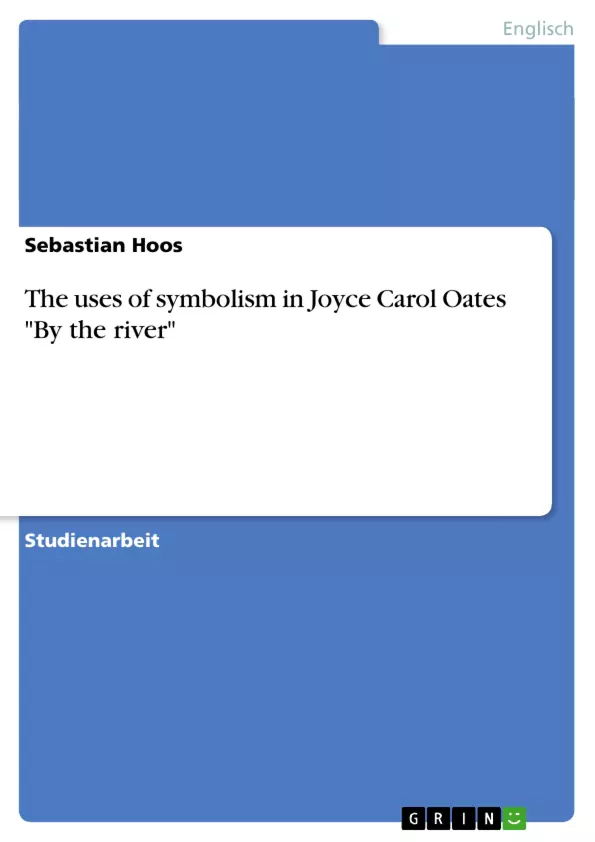University of Tübingen, Department of American Studies
PSII: Contemporary American Short Fiction
The uses of symbolism in Joyce Carol Oates "By the river"
von: Sebastian Hoos
Her work has been compared to the ‘cyclorama’, a device that allowed viewers in the 19th century to see both the overall contours and specific details of historical events and discoveries of the time. Those cycloramas traveled from tiny hamlets to small towns to large cities throughout the United States. While the enormous pictures distorted reality for artistic effect, the studied misinterpretation did not matter to audiences because the cycloramas showed them individuals and episodes they would otherwise never see...
Inhaltsverzeichnis
- The Uses of Symbolism in Joyce Carol Oates's "By the River"
- Introduction
- The Homecoming
- The Journey Home: Helen's Return
- A Symbol of Continuity and Stability: The Bus Station
- Signs of a Troubled Past: Flies, the Ticket Lady, and the Candy Bar Machine
- The Ambiguity of Protection: Helen's Relationship with her Father
- The Recurring Image of Perishability and Death
- Conclusion: The Symbolism of "By the River"
Zielsetzung und Themenschwerpunkte
Diese Arbeit analysiert die Verwendung von Symbolen in Joyce Carol Oates' Kurzgeschichte "By the River" und untersucht, wie diese Symbole zum Verständnis des größeren Kontextes und der Themen der Geschichte beitragen. Ziel ist es, die Bedeutung dieser Symbole im Rahmen der literarischen Gattung der Kurzgeschichte aufzuzeigen.
- Die Rückkehr der Protagonistin Helen in ihre Heimatstadt
- Die Suche nach Kontinuität und Stabilität in einer sich verändernden Welt
- Das ambivalente Verhältnis von Helen zu ihrer Vergangenheit
- Die Darstellung von Gewalt und sexueller Missbrauch
- Die Wiederkehrende Thematik von Vergänglichkeit und Tod
Zusammenfassung der Kapitel
- The Uses of Symbolism in Joyce Carol Oates's "By the River": Dieses Kapitel führt die Geschichte von "By the River" ein und stellt den Ansatz der Analyse anhand von Symbolen vor.
- Introduction: In diesem Kapitel wird Joyce Carol Oates' Schaffen und ihre Schreibweise kurz vorgestellt. Der Fokus liegt auf ihren Kurzgeschichten und ihrer besonderen Fähigkeit, komplexe Themen und menschliche Beziehungen in kurzen, prägnanten Erzählungen darzustellen.
- The Homecoming: Dieses Kapitel behandelt die Rückkehr der Protagonistin Helen in ihre Heimatstadt Oriskany. Es werden die Umstände ihrer Flucht aus ihrem aktuellen Leben und ihre Sehnsucht nach einem Ort der Vertrautheit und Stabilität erläutert.
- The Journey Home: Helen's Return: Dieser Abschnitt beleuchtet die Ankunft von Helen in Oriskany und ihre Begegnung mit Orten und Personen aus ihrer Vergangenheit. Es wird hervorgehoben, wie die Umgebung und die Begegnungen mit vertrauten Personen ihr Gefühl von Orientierung und Sicherheit beeinflussen.
- A Symbol of Continuity and Stability: The Bus Station: Dieses Kapitel interpretiert die Busstation als Symbol für Kontinuität und Stabilität, das Helen Hoffnung auf eine geordnete und vertraute Welt bietet. Der Kontrast zwischen ihrer Vergangenheit und ihrem jetzigen Leben wird deutlich.
- Signs of a Troubled Past: Flies, the Ticket Lady, and the Candy Bar Machine: Dieser Abschnitt beleuchtet die Symbole, die Helen begegnen und die ihr Unbehagen und Unsicherheit signalisieren. Die Fliesen, die Ticket-Dame und die Spiegelung in der Süßwarenmaschine werden als Zeichen ihrer schwierigen Vergangenheit und ihrer Ängste gedeutet.
- The Ambiguity of Protection: Helen's Relationship with her Father: Dieses Kapitel analysiert das ambivalente Verhältnis von Helen zu ihrem Vater und die Bedeutung seiner Hände als Symbol für Schutz. Die Beschreibung seiner Hände und seine Handlungen lösen bei Helen widersprüchliche Gefühle aus, die die Komplexität ihres Vater-Tochter-Verhältnisses aufzeigen.
- The Recurring Image of Perishability and Death: Dieser Abschnitt untersucht die Wiederholung des Motivs der Vergänglichkeit und des Todes in der Geschichte. Die Telefonate mit ihrem Vater, ihre eigenen Gedanken und die Begegnungen mit ihrer Umwelt tragen zu diesem ambivalenten Gefühl bei.
Schlüsselwörter
Die Schlüsselwörter dieser Arbeit beinhalten "Symbolismus", "Kurzgeschichte", "Joyce Carol Oates", "Heimkehr", "Vergangenheit", "Kontinuität", "Stabilität", "Ambivalenz", "Schutz", "Vergänglichkeit", "Tod". Diese Begriffe repräsentieren die zentralen Themen und Ideen, die in "By the River" untersucht werden. Die Analyse der Symbole in der Geschichte liefert Einblicke in die komplexen Beziehungen zwischen der Protagonistin, ihrer Vergangenheit und ihrem neuen Lebensweg.
- Quote paper
- MA Sebastian Hoos (Author), 1996, The uses of symbolism in Joyce Carol Oates "By the river", Munich, GRIN Verlag, https://www.grin.com/document/35446



